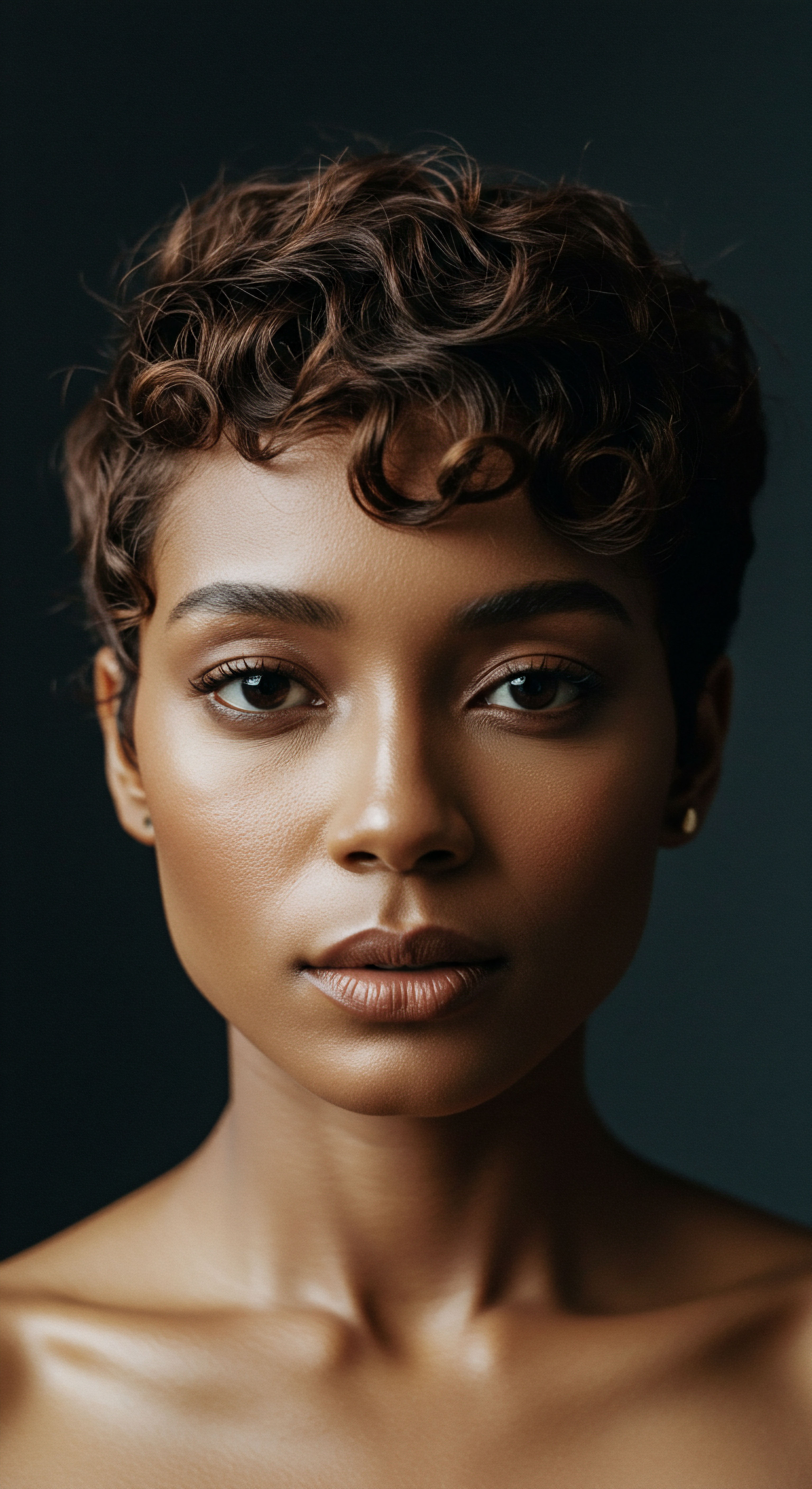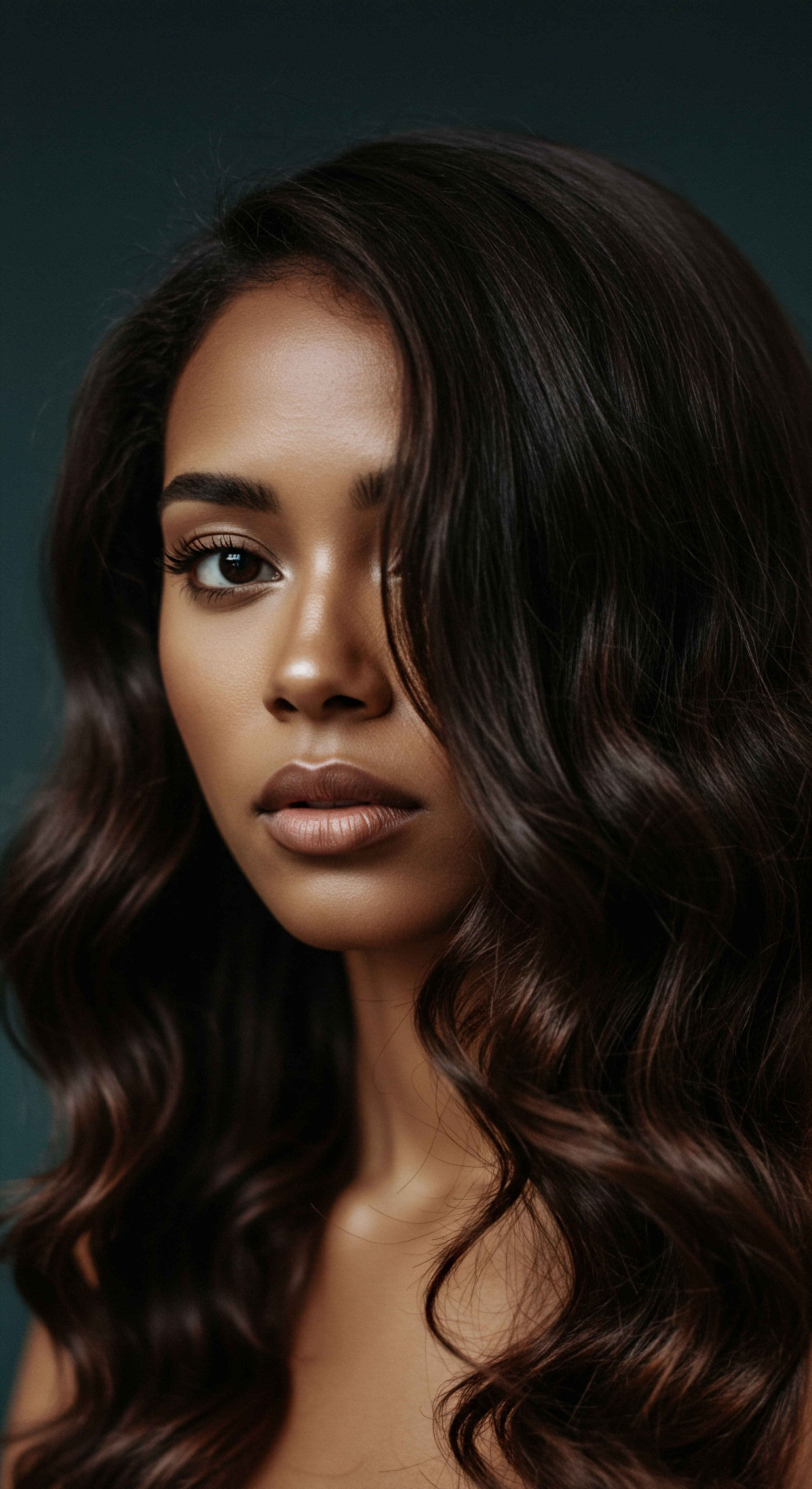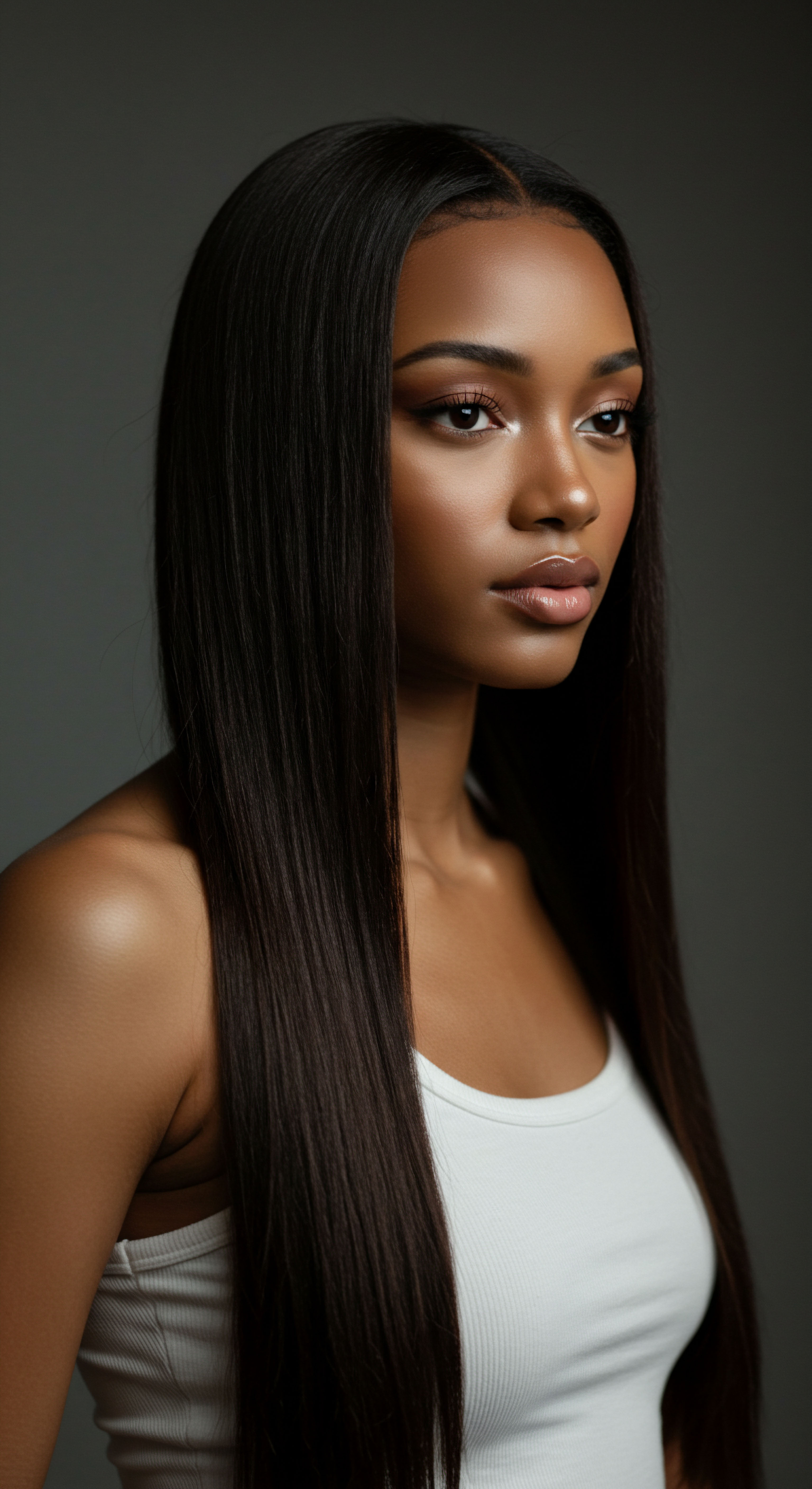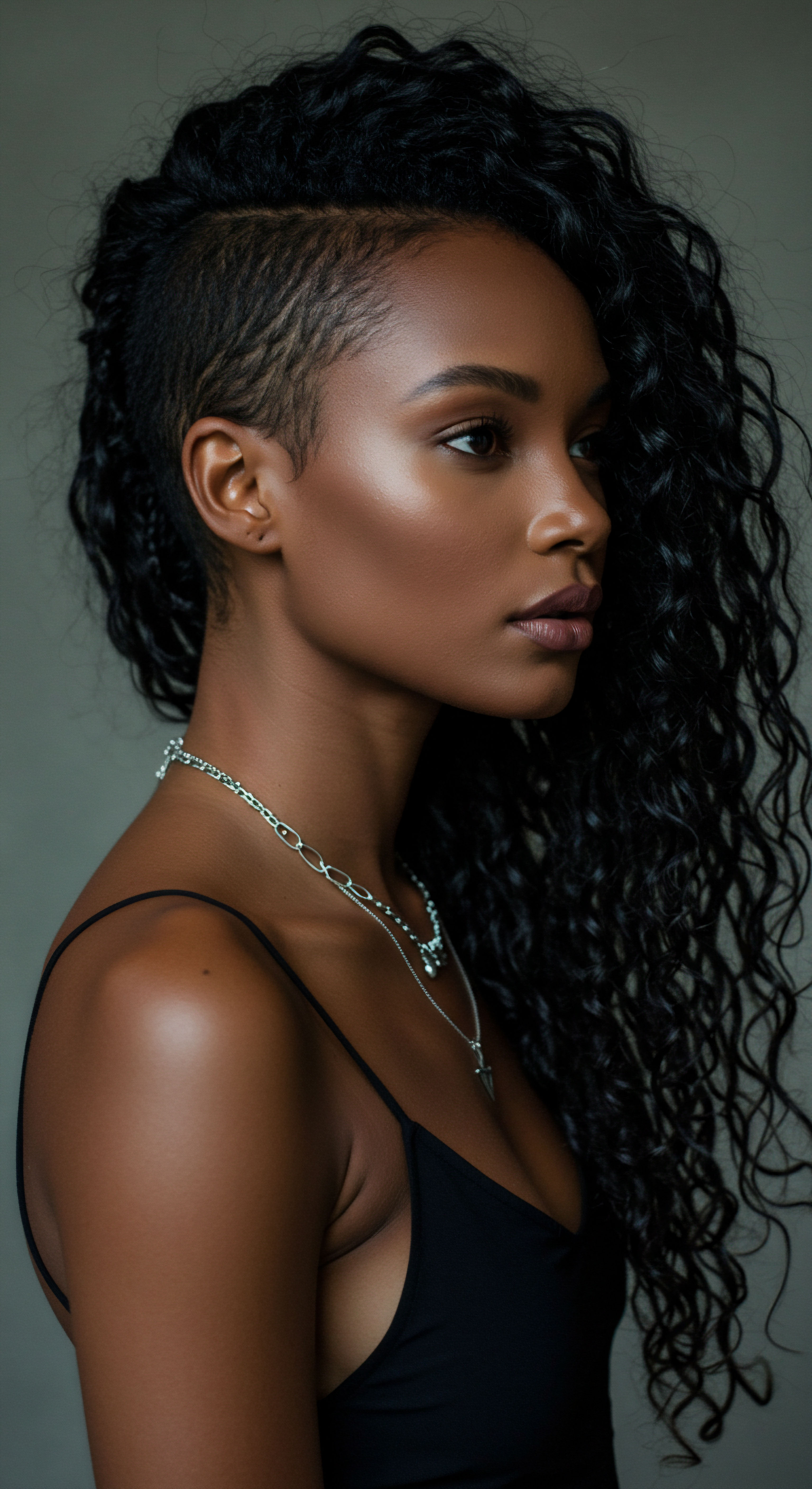
Roots
Our hair, particularly textured hair, holds stories within its very structure—tales of resilience, adaptation, and a deep connection to identity. We often observe our strands, feeling their unique contours, their response to the air, to water, to touch. This quiet observation can lead to a fundamental question ❉ what truly makes hair strong, truly allows it to thrive? At its essence, hair is a protein fiber, primarily composed of a remarkable protein known as Keratin.
This natural building block gives hair its inherent strength, its elasticity, and its protective outer layer. Yet, daily life, environmental shifts, and styling rituals can challenge this delicate balance, prompting us to seek external allies in the quest for lasting hair health.
Within this foundational understanding, we begin to consider external proteins, and among them, silk protein emerges as a fascinating subject. Silk, a natural biopolymer produced by silkworms, consists mainly of two proteins ❉ Fibroin and Sericin. Fibroin forms the core fibrous structure, contributing to silk’s mechanical properties, while sericin acts as a sticky, protective outer layer.
Both possess qualities that have captivated human attention for centuries, not only in textiles but increasingly in cosmetic science. The contemplation here centers on how these proteins, distinct from our hair’s native keratin, might interact with textured strands, potentially contributing to their structural integrity.
Hair’s fundamental strength stems from keratin, a protein whose delicate balance can be supported by external allies like silk protein.

Hair’s Intrinsic Architecture
To truly appreciate the potential contributions of silk protein, we must first recognize the inherent complexity of textured hair. Unlike straight strands, textured hair exhibits a distinct elliptical cross-section and often a varied curl pattern, from loose waves to tight coils. This unique shape influences how light reflects, how moisture is retained or lost, and how susceptible the hair might be to mechanical stress. The outermost layer, the Cuticle, consists of overlapping scales, much like shingles on a roof.
When these scales lie flat, they provide a smooth surface that protects the inner cortex. Damage, whether from chemical treatments, heat, or environmental factors, can cause these cuticles to lift, leading to increased porosity and vulnerability.
Beneath the cuticle lies the Cortex, the hair’s primary structural component. This region is a dense network of keratin proteins, linked together by various bonds, including disulfide bonds, hydrogen bonds, and salt bonds. These connections are responsible for hair’s elasticity, its ability to stretch and return to its original shape without breaking.
A healthy cortex signifies resilient hair. The innermost part is the medulla, a soft, sometimes absent core, whose precise function in hair strength remains an area of ongoing scientific inquiry.

What Defines Structural Integrity in Hair?
Structural integrity in hair speaks to its overall health and resilience. It is the hair’s capacity to withstand daily manipulation, environmental aggressors, and styling practices without breaking or experiencing significant degradation. This concept extends beyond mere appearance; it relates to the hair’s internal strength, its ability to retain moisture, and its resistance to damage. Hair with robust structural integrity will exhibit:
- Strength ❉ The ability to resist breaking under tension.
- Elasticity ❉ The capacity to stretch and return to its original length without snapping.
- Smoothness ❉ A cuticle layer that lies flat, minimizing friction and tangles.
- Moisture Retention ❉ The ability to hold onto water, preventing dryness and brittleness.
When hair lacks these qualities, it may feel rough, appear dull, break easily, or struggle to hold a style. Understanding these markers helps us evaluate the efficacy of any treatment, including those featuring silk protein.
| Component Cuticle |
| Primary Composition Keratin scales |
| Key Role in Hair Integrity Protective outer layer, influences shine and smoothness |
| Component Cortex |
| Primary Composition Keratin protein chains |
| Key Role in Hair Integrity Provides strength, elasticity, and determines hair shape |
| Component Medulla |
| Primary Composition Soft, amorphous cells (sometimes absent) |
| Key Role in Hair Integrity Function less understood, may contribute to overall diameter |
| Component Understanding these elements is foundational to comprehending how external agents might interact with hair. |

Ritual
As we navigate the daily dance of caring for our textured strands, a desire for tangible improvement often guides our choices. We seek practices and products that offer not just fleeting softness, but a lasting sense of vitality. This section steps into that space of practical wisdom, moving from the elemental understanding of hair to the deliberate application of care.
How do we, in our personal rituals, truly invite the potential of ingredients like silk protein to contribute to the structural integrity of textured hair? The answer lies in the mindful selection and consistent use of products, observing how our hair responds to these purposeful additions.
The introduction of silk protein into hair care regimens often comes through conditioners, masks, and leave-in treatments. These formulations are designed to deliver the beneficial properties of silk to the hair shaft. The very act of applying a rich mask, smoothing a conditioner through coils, or gently working a leave-in product into damp strands becomes a ritual, a moment of connection with our hair’s needs. The sensory experience — the slip, the gentle detangling, the immediate softness — offers the first hint of silk’s potential.
Mindful application of silk protein products within hair care rituals can reveal their tangible benefits for textured strands.

Incorporating Silk Protein into Hair Routines
The efficacy of silk protein in hair care is closely tied to its form and molecular weight. Often, silk proteins are Hydrolyzed, meaning they are broken down into smaller peptides or amino acids. This process is crucial because smaller molecules are better able to penetrate the hair shaft, moving beyond merely coating the surface. Hydrolyzed silk protein, with its lower molecular weight, can indeed absorb into the hair, offering a more substantive interaction than larger protein molecules.
For textured hair, which can be prone to dryness and breakage due to its unique structure, the ability of hydrolyzed silk to bind to keratin and form a protective layer is particularly relevant. This protective action can help to seal in moisture and reduce friction, which are significant factors in maintaining the integrity of delicate curls and coils.

How Do Silk Proteins Interact with Hair?
When applied to hair, particularly damaged hair, silk proteins can interact in several ways:
- Cuticle Adherence ❉ Smaller silk protein fragments can settle into the lifted scales of a damaged cuticle, effectively smoothing the surface. This creates a more uniform outer layer, reducing tangles and enhancing shine.
- Moisture Binding ❉ Silk proteins, especially sericin, are hydrophilic, meaning they attract and hold water. This humectant property helps to draw moisture from the environment and bind it to the hair, contributing to hydration and elasticity.
- Internal Support ❉ Hydrolyzed silk protein, with its amino acid composition, can penetrate the hair cortex. There, it can supplement the hair’s natural protein structure, potentially enhancing its internal strength and flexibility. This is particularly beneficial for hair that has lost protein due to chemical treatments or heat styling.
The sensation of hair feeling softer, smoother, and more pliable after using silk protein products is a direct result of these interactions. For those with high porosity hair, where the cuticle is more open, silk proteins can be especially beneficial in providing a temporary seal, helping to reduce moisture loss.

The Delicate Balance ❉ Protein and Moisture
While silk protein offers clear benefits, the journey of textured hair care is one of balance. Hair needs both protein and moisture to thrive. Too much protein, without adequate moisture, can lead to a condition often called Protein Overload.
This can cause hair to feel stiff, brittle, and prone to breakage, even if it appears stronger. Conversely, hair lacking sufficient protein may feel mushy, limp, and overly stretchy.
Recognizing the signs of this imbalance is key to a healthy regimen. A simple stretch test can offer insight ❉ if a wet strand stretches and then snaps, it may signal a need for more moisture. If it stretches but feels gummy and does not return to its shape, it might indicate a need for protein. Products formulated with a thoughtful combination of silk proteins and moisturizing agents often yield the most harmonious results for textured hair.
| Protein Type Hydrolyzed Silk Protein |
| Molecular Weight (General) Low (e.g. < 2000 Da) |
| Primary Interaction with Hair Penetrates cortex, binds to keratin, internal repair, moisture binding |
| Protein Type Larger Proteins (e.g. some Collagen) |
| Molecular Weight (General) High (e.g. > 9000 Da) |
| Primary Interaction with Hair Forms film on surface, external protection, conditioning |
| Protein Type The size of the protein molecule significantly impacts its ability to penetrate and interact with the hair fiber. |

Relay
Stepping deeper into the conversation surrounding silk protein and textured hair, we find ourselves at a fascinating intersection of molecular science, historical practice, and individual experience. The initial questions about structural integrity give way to more intricate inquiries ❉ how precisely do these external proteins interact with our hair’s inherent architecture, and what can contemporary research tell us about their long-term impact? This exploration invites us to consider not only the visible benefits but also the underlying mechanisms and the broader cultural context that has long valued silk for its unique qualities.
The story of silk, beyond its scientific properties, carries echoes of ancient wisdom. For millennia, cultures across the globe have revered silk, not just for its luxurious feel, but for its perceived benefits in personal care. From Chinese empresses who spun threads from cocoons to West African women who donned vibrant silk headwraps, the material has held a place of honor. This deep cultural appreciation hints at an intuitive understanding of silk’s gentle nature and its protective qualities for hair, long before laboratories could dissect its protein components.
The enduring cultural appreciation for silk’s benefits for hair aligns with modern scientific insights into its protein interactions.

Unraveling the Molecular Dialogue ❉ Silk and Keratin
At the microscopic level, the interaction between silk protein and hair’s keratin is a complex molecular dialogue. Hair’s primary protein, keratin, is rich in cysteine, an amino acid containing sulfur. These sulfur atoms form disulfide bonds, which are crucial for hair’s strength and shape. When hair is damaged, these bonds can be broken, and the hair’s protein structure compromised.
Silk protein, particularly Hydrolyzed Silk Protein, is composed of amino acids like serine, glycine, and alanine. Some research suggests that hydrolyzed silk protein can provide cysteine, an essential amino acid for keratin production, thus potentially aiding in strengthening and repairing damaged strands. Moreover, the smaller peptides derived from hydrolyzed silk have a high affinity for keratin, allowing them to bind to the hair shaft. This binding action can help to temporarily fill in gaps and smooth the cuticle, contributing to improved elasticity and reduced breakage.
A study published in 2018 in the journal Health improvement of human hair and their reshaping using recombinant keratin K31 explored the effects of applying recombinant human keratin K31 to chemically damaged hair. While focusing on keratin, this research offers a compelling parallel to the potential of external proteins like silk. The study observed that after a single treatment, the mechanical strength of bleached hair significantly increased, almost doubling.
This suggests that external protein supplementation, when appropriately formulated and absorbed, can indeed contribute to a measurable improvement in hair’s structural resilience. While silk protein is distinct from keratin, this study underscores the principle that adding protein components can restore integrity to compromised hair.

Does Silk Protein Truly Strengthen from Within?
The question of whether silk protein truly integrates into the hair’s structure or merely forms a temporary surface film is a point of ongoing scientific discussion. Evidence suggests a dual action:
- Surface Protection ❉ Larger silk protein molecules and oligopeptides can form a protective film on the hair’s surface. This film acts as a barrier, reducing moisture loss, providing a smoother feel, and offering some defense against environmental stressors like UV radiation. This surface action is particularly beneficial for sealing the cuticle of porous hair.
- Cortical Penetration ❉ Critically, the smaller, hydrolyzed silk peptides and amino acids possess the molecular size to penetrate beyond the cuticle and into the cortex. Once inside, they can interact with the existing keratin network, potentially reinforcing weakened areas. This internal action contributes to improvements in hair elasticity and tensile strength, making the hair more resilient to stretching and breakage.
The degree of penetration is influenced by factors such as the protein’s molecular weight, the hair’s porosity, and the presence of other ingredients in the formulation. For textured hair, which often has a more open cuticle, the absorption of these smaller protein fragments can be quite effective.

The Cultural Resonance of Silk and Hair
Beyond the laboratory, the enduring association of silk with hair health is deeply rooted in diverse cultural practices. For centuries, women in various traditions have turned to silk for its perceived benefits.
In East Asian cultures, particularly China, where silk originated over 5,000 years ago, silk hair wraps were not only symbols of status but also practical tools for hair care. Geishas in Japan, for instance, used silk wraps to preserve their elaborate hairstyles and minimize damage during sleep, intuitively understanding silk’s low-friction properties. Similarly, in South Asia, Indian women utilized silk scarves to shield their hair from dust, sun, and pollution, recognizing its ability to reduce friction and prevent breakage.
The practice of hair wrapping with silk has also been significant in African and African diaspora cultures, often seen in the form of headwraps or bonnets. This tradition speaks to a long-standing understanding of how to protect delicate hair textures from friction and moisture loss, especially during sleep. The gentle, smooth surface of silk helps to maintain curl patterns, reduce frizz, and minimize mechanical stress that can lead to breakage. These historical and ongoing practices lend a rich, human dimension to the scientific inquiry into silk’s benefits, suggesting that intuitive wisdom often precedes detailed scientific explanation.

Reflection
The journey through hair’s foundational nature, the mindful application of care, and the intricate dance of science and cultural practice reveals a nuanced understanding of silk protein’s place in nurturing textured hair. It is a testament to the quiet power of ingredients, both ancient and scientifically affirmed, that we continue to seek ways to honor and strengthen our strands. The conversation around silk protein’s contribution to structural integrity moves beyond a simple yes or no, inviting us instead to consider the symphony of interactions that define hair health. Our hair, with its diverse textures and rich histories, remains a remarkable canvas, always responsive to thoughtful attention and genuine understanding.

References
- 1. Saravanakumar, A. & Santhanam, V. (2022). Potential of silk proteins in cosmetics. ResearchGate .
- 2. Gingerlily. (2024). Silk Protein and The Benefits It Has On Hair. Gingerlily .
- 3. Prose. (n.d.). Silk Proteins. Prose .
- 4. Colleen. (2022). SILK PROTEINS – CAN THEY MAKE HAIR DREAMS COME TRUE? Colleen .
- 5. Halo Haircare Society. (2024). So you think your hair is sensitive to protein? Halo Haircare Society .
- 6. Fan, S. & Wu, X. (2025). Performance and Mechanism of Hydrolyzed Keratin for Hair Photoaging Prevention. MDPI .
- 7. Cosmetics Ingredient INCI. (n.d.). HYDROLYZED SILK. Cosmetics Ingredient INCI .
- 8. Silkbiotic. (n.d.). The Scientifically Proven Benefits of Silk for Skin and Hair. Silkbiotic .
- 9. Esme Luxury. (2024). Silk Hair Wraps in Different Cultures ❉ A Global Perspective. Esme Luxury .
- 10. Strands of Silk. (2020). The rich history of silk and hair wrapping. Strands of Silk .
- 11. Pattern Beauty. (2024). Is Your Natural Texture Experiencing Protein Overload? Pattern Beauty .
- 12. HeyCurls. (2022). Does Your Hair Need Protein or Moisture? Here’s How to Tell. HeyCurls .
- 13. Blissy. (2022). How the Silk Protein Sericin Helps Hair and Skin. Blissy .
- 14. Labedzka, M. Stimpson, S. Varçin, M. Grant-Ross, P. & Tamburic, S. (n.d.). An ex vivo comparative study of the tensile strengthening efficacy of protein-derived actives on heavily bleached hair. London College of Fashion, University of the Arts London .
- 15. JM. (2025). Silk Ribbon Hairstyles ❉ Chinese-Inspired Trends for 2025. JM .
- 16. FEBS Biyoteknoloji. (2022). Wonderful Ingredient in Hair Care; Silk. FEBS Biyoteknoloji .
- 17. Fix Salon. (2024). Celebrating Diversity ❉ Cultural Influences on Hair. Fix Salon .
- 18. Serione. (2024). Silk Proteins Showdown ❉ Fibroin vs Sericin – Which Reigns Supreme in Hair Care? Serione .
- 19. Treeactiv. (n.d.). Silk Amino Acid Cosmetic Raw Material Hydrolyzed Silk Protein For Body Care Product. Treeactiv .
- 20. Proteina. (n.d.). Silk. Proteina .
- 21. Blissy. (2023). How the Silk Protein Sericin Helps Hair and Skin Guide 101. Blissy .
- 22. Scented Expressions. (n.d.). Hydrolyzed Silk Protein. Scented Expressions .
- 23. Sheena’s Hair Care. (2024). Strengthen ❉ The Ultimate Treatment Gel For High-Porosity Curls. Sheena’s Hair Care .
- 24. The History of The Hair Fiber. (n.d.). The Royale Solution Hair Fibers .
- 25. FEBS Biotechnology. (2022). Silk Protein in Hair Care. FEBS Biotechnology .
- 26. Beauty Insights Hub. (n.d.). Is Protein Good for Low Porosity Hair? A Complete Guide. Beauty Insights Hub .
- 27. Curl Warehouse. (2020). Product Absorption and Low Porosity Hair. Curl Warehouse .
- 28. Labedzka, M. & Tamburic, S. (2016). An ex vivo Comparison of the Tensile-Strengthening Properties of Protein Derivatives on Damaged Hair. UAL Research Online .
- 29. Gift Hamper Hong Kong. (2024). Understanding the Tradition of Hair Dressing Ceremonies. Gift Hamper Hong Kong .
- 30. I Love Riccio. (2023). Understanding Hair Elasticity ❉ How to Assess & Improve The Strength of Your Curls. I Love Riccio .
- 31. Curlsmith. (n.d.). Best Protein-Rich Products for Curly Hair. Curlsmith .
- 32. Fan, S. & Wu, X. (2025). Performance and Mechanism of Hydrolyzed Keratin for Hair Photoaging Prevention. Preprints.org .
- 33. I Love Riccio. (n.d.). How elastic is your curly hair? I Love Riccio .
- 34. The Formulator Shop. (n.d.). Hydrolysed Silk Protein. The Formulator Shop .
- 35. Lee, Y. S. & Kim, Y. H. (2017). Use of silk proteins for hair care. Google Patents .
- 36. CG Curls. (2023). What are the best proteins for low and high porosity hair? CG Curls .
- 37. Singh, M. Singh, S. Singh, A. Singh, N. & Singh, R. (2018). Health improvement of human hair and their reshaping using recombinant keratin K31. Protein Expression and Purification, 142, 1-7.
- 38. Wikipedia. (n.d.). Silk amino acid. Wikipedia .
- 39. SAVE ME FROM. (2022). 5 Hair Benefits of Silk Protein to Soften + Strengthen Damaged Hair. SAVE ME FROM .
- 40. Eazicolor Professional. (2024). The Role Of Protein In Hair Health. Eazicolor Professional .
- 41. Sew Historically. (2019). History Of The Nightcap – Victorian And Edwardian Hair Care. Sew Historically .
- 42. Byrdie. (2022). It’s Time to Learn the History Behind The Silk Press. Byrdie .